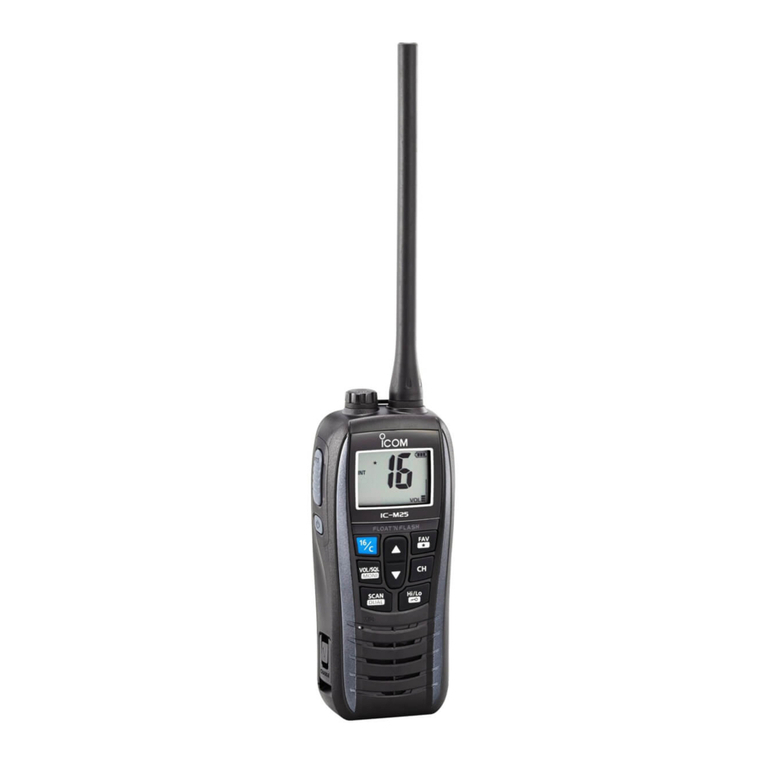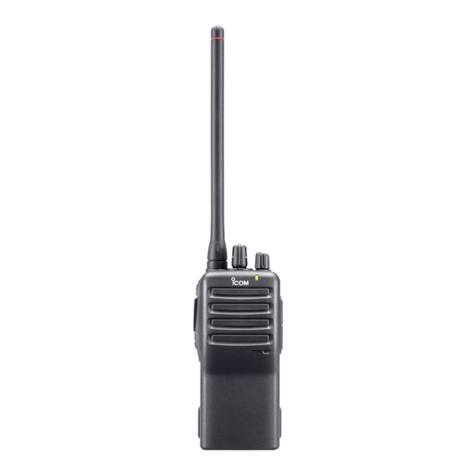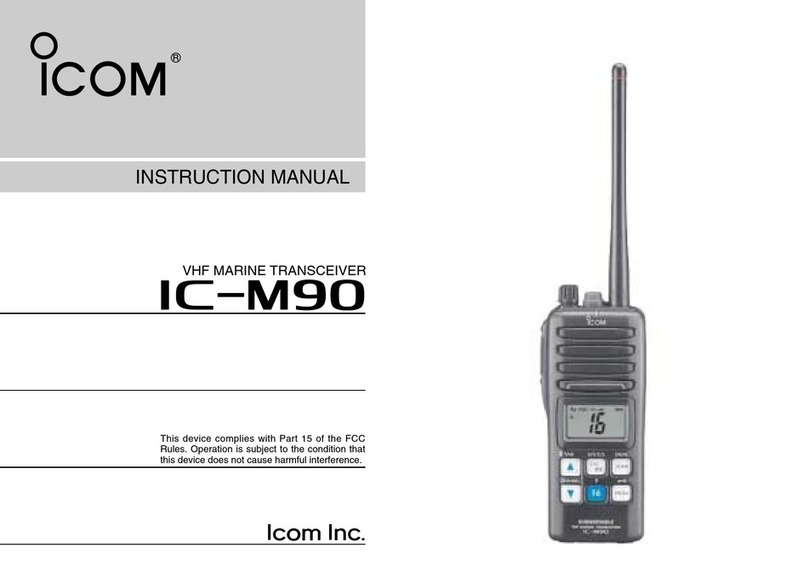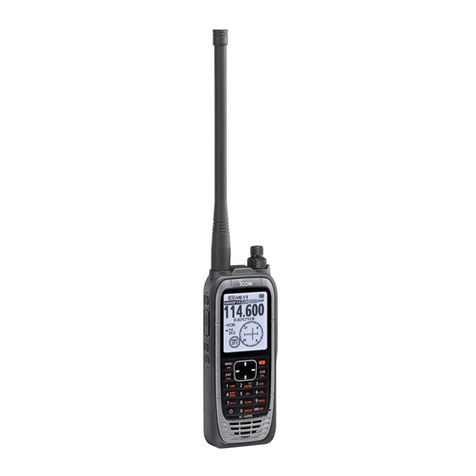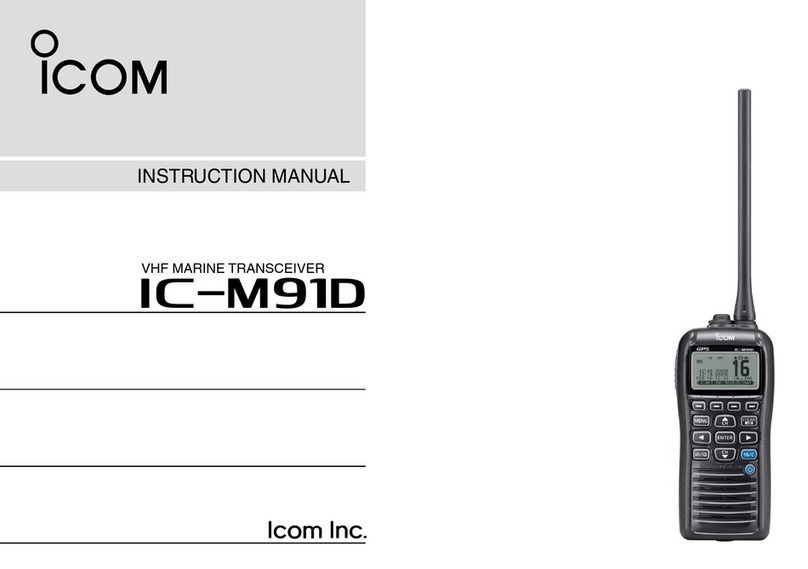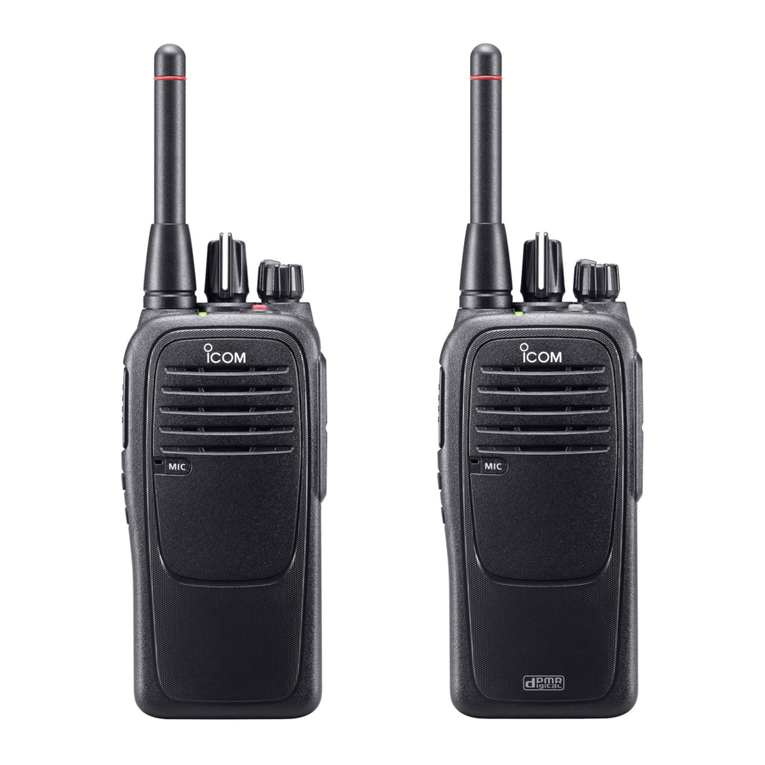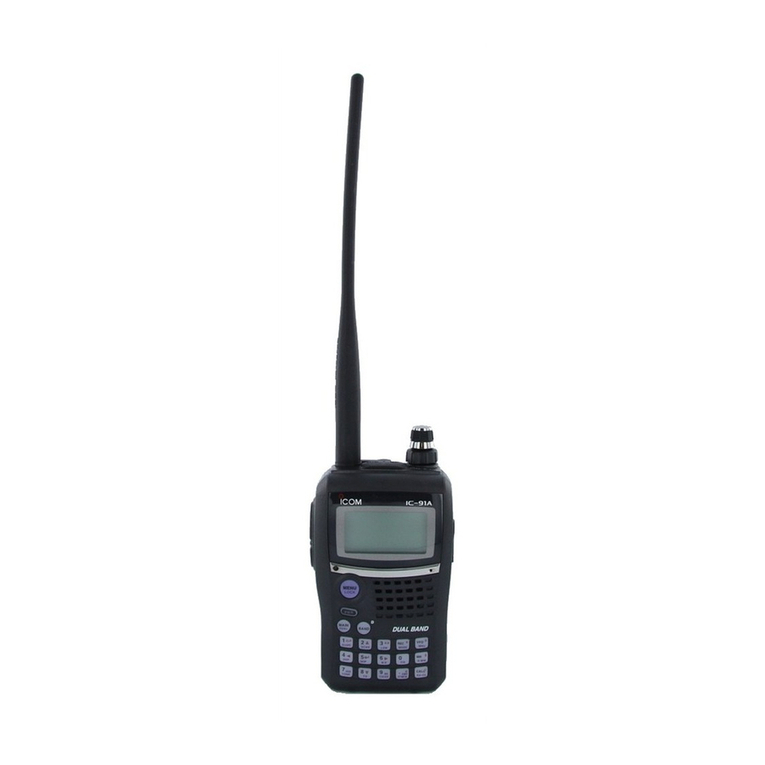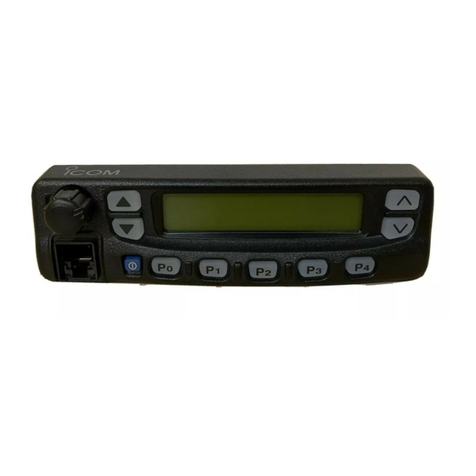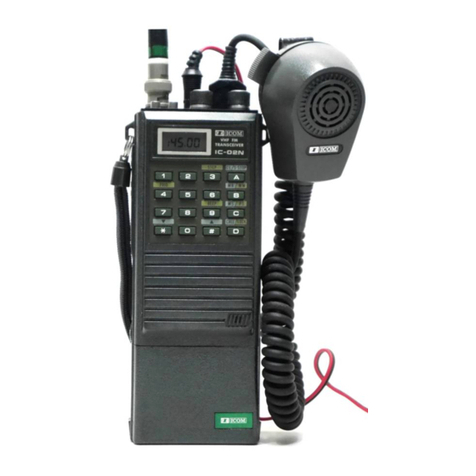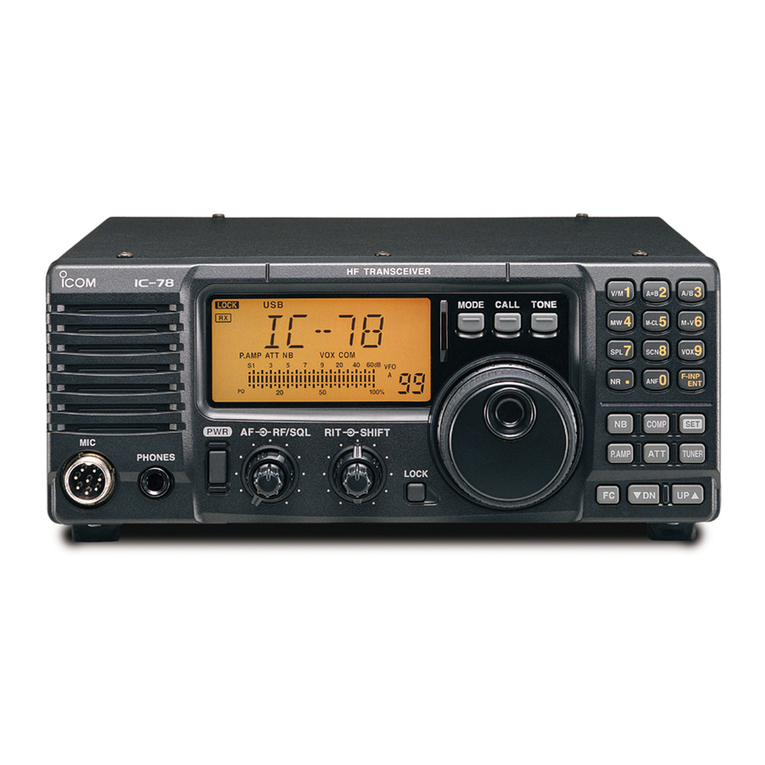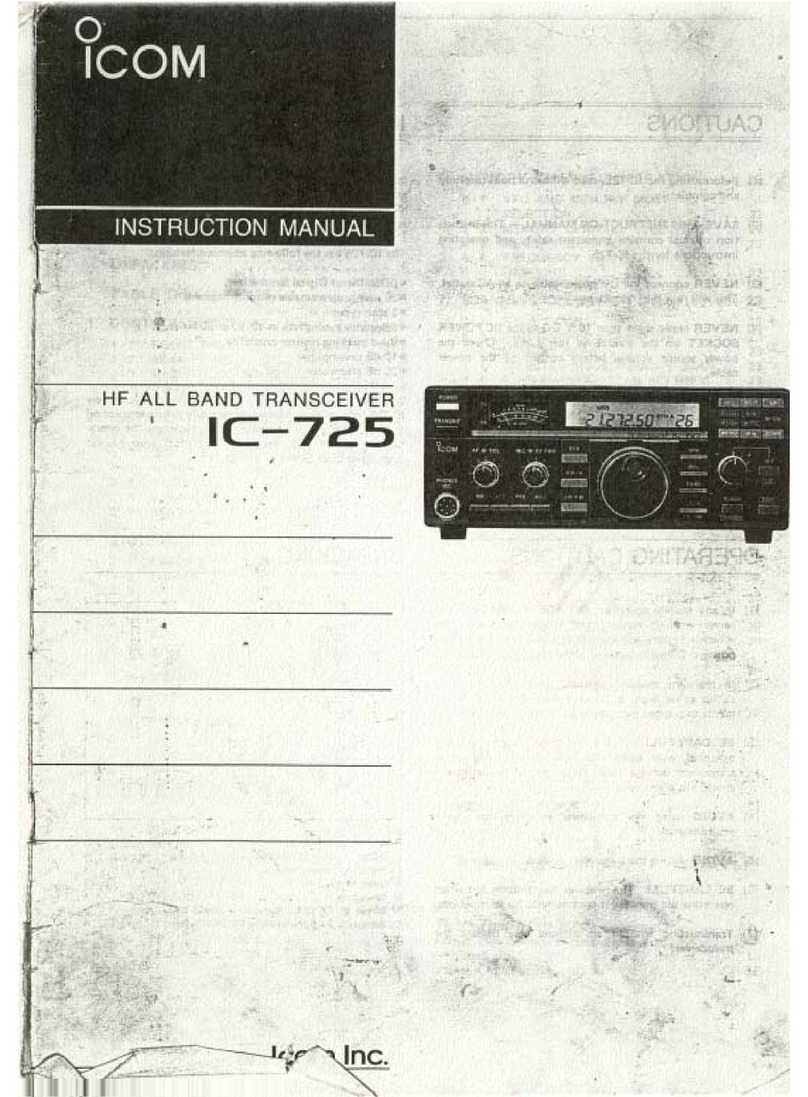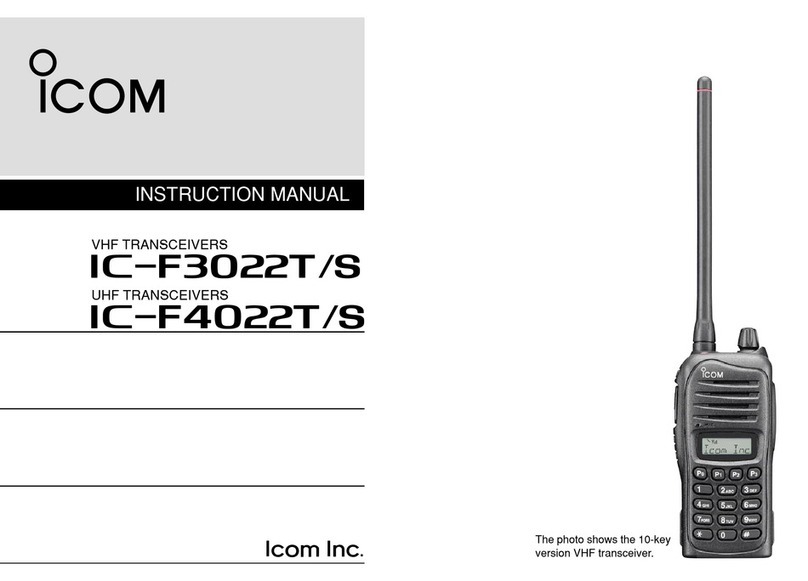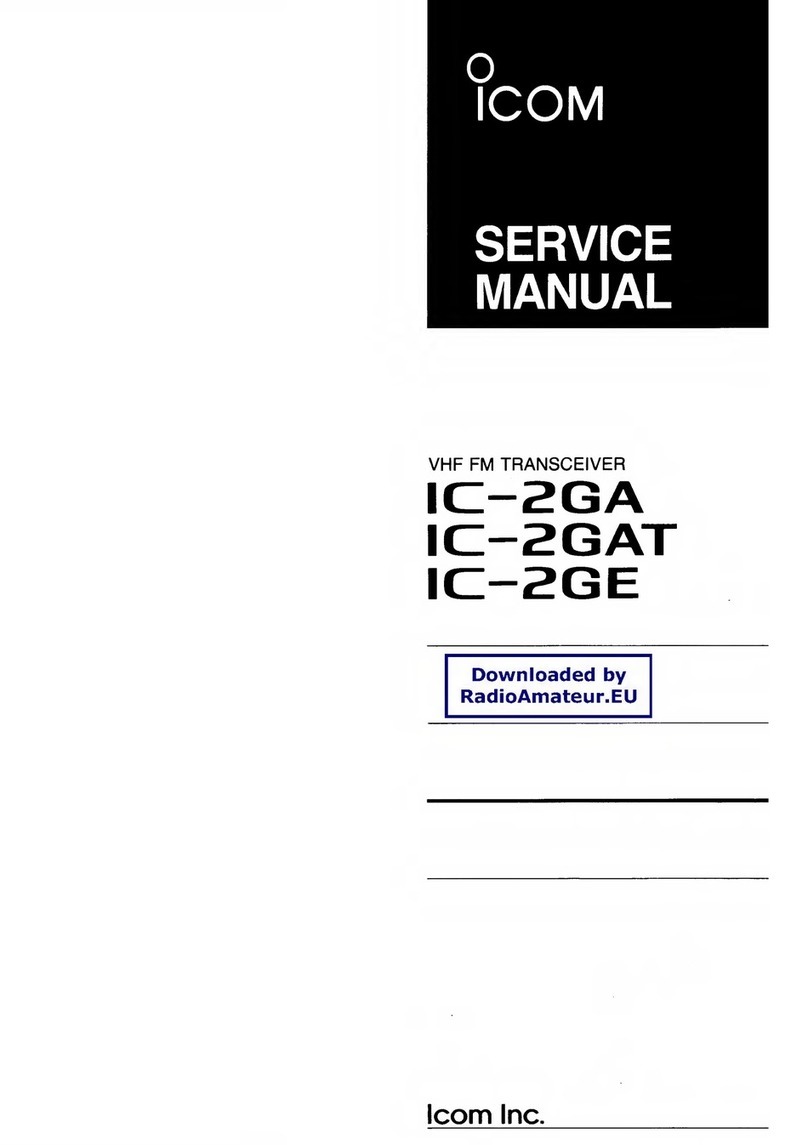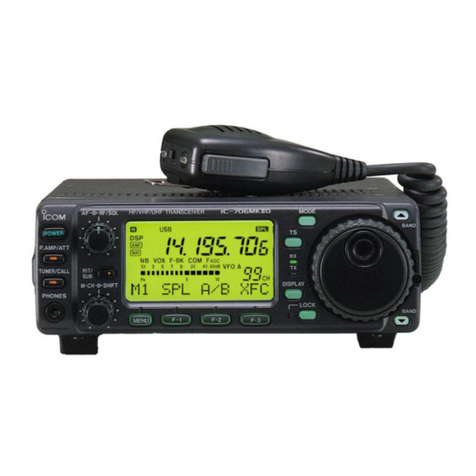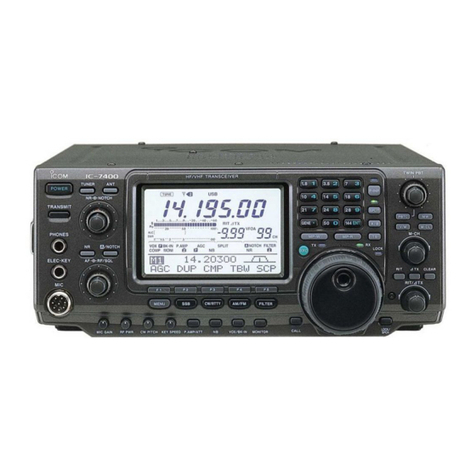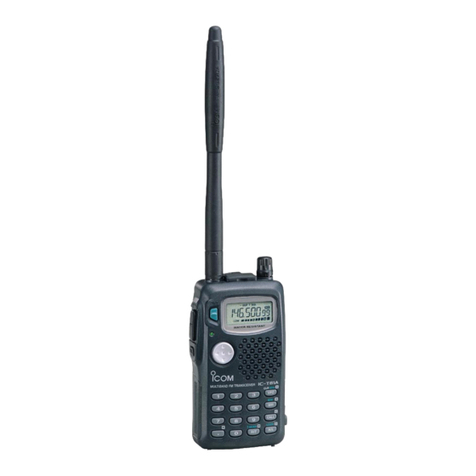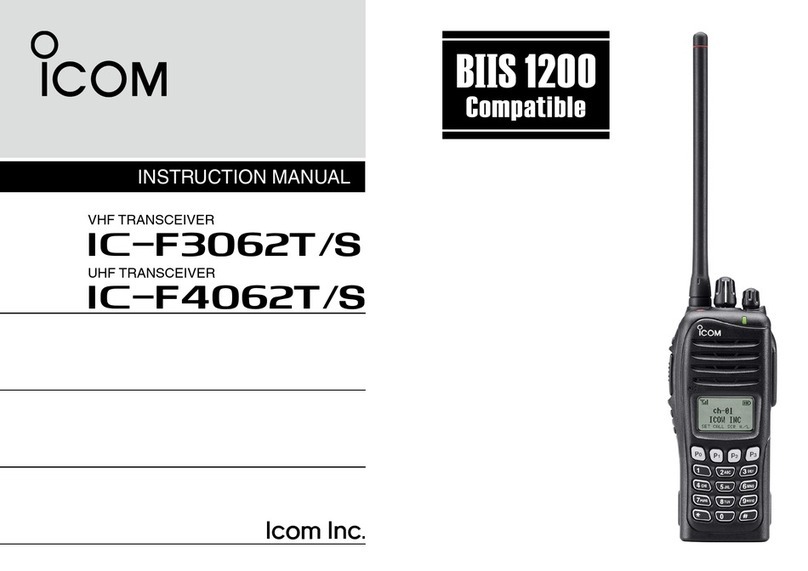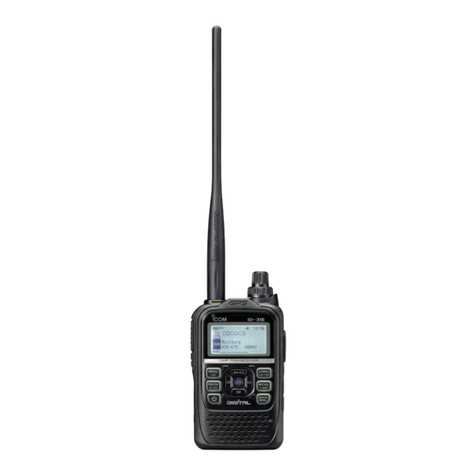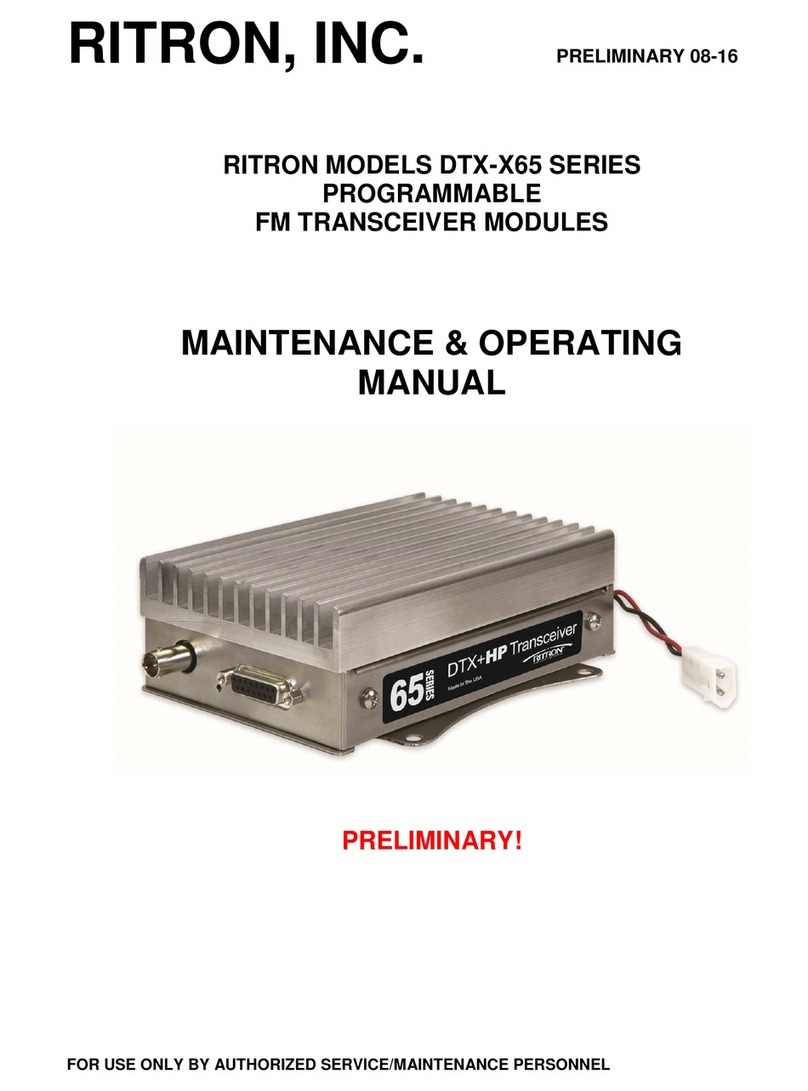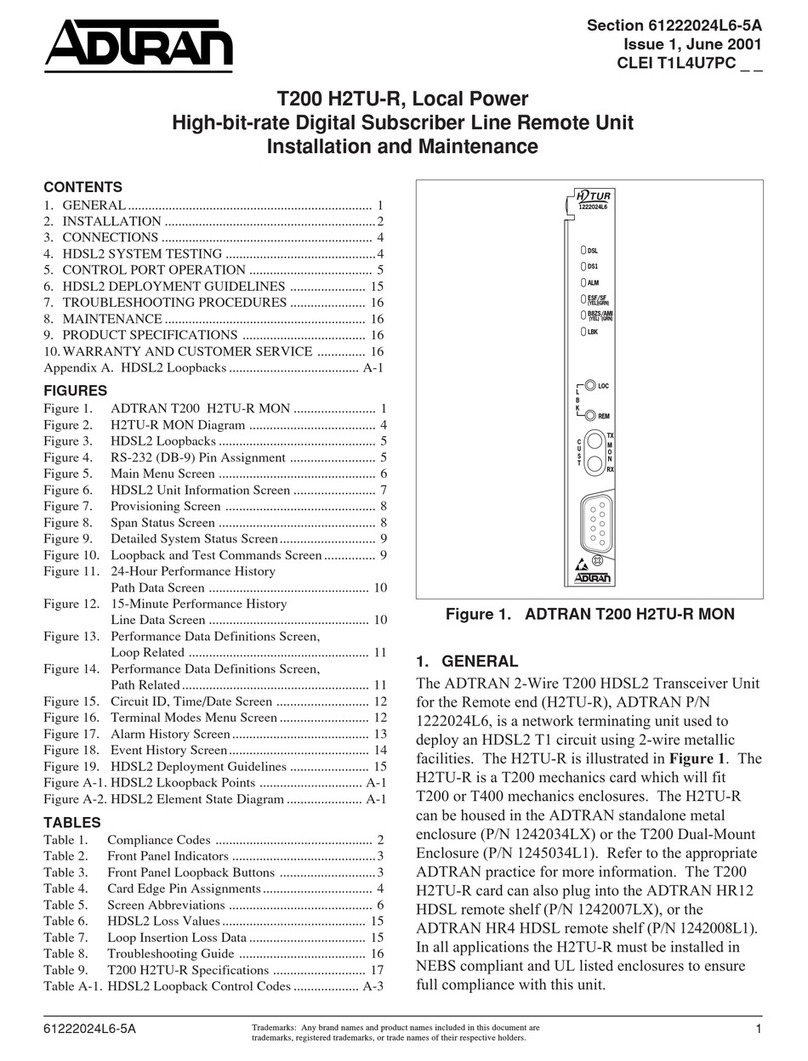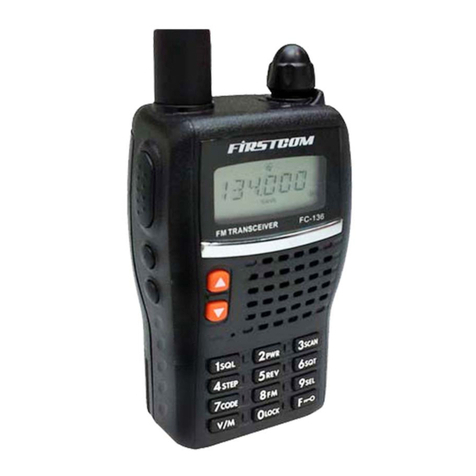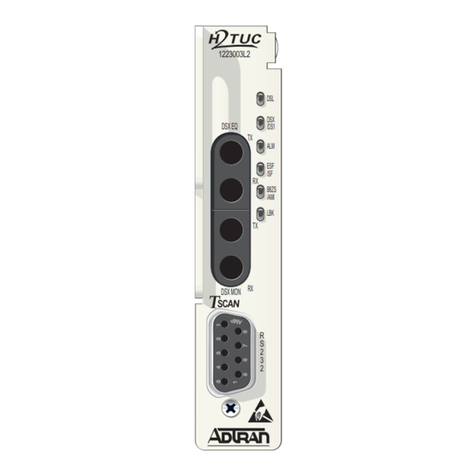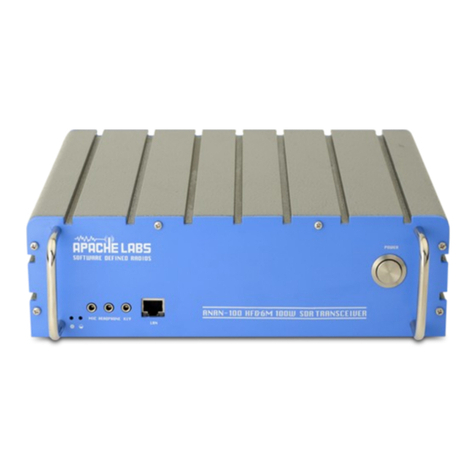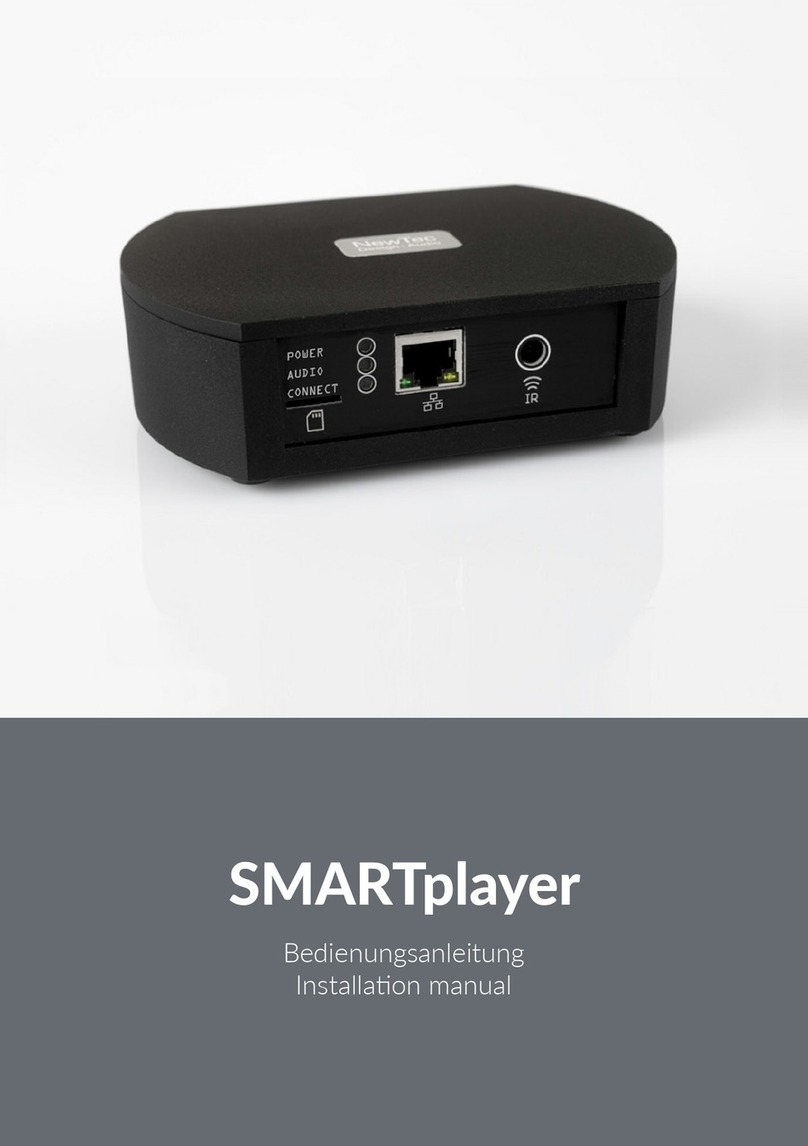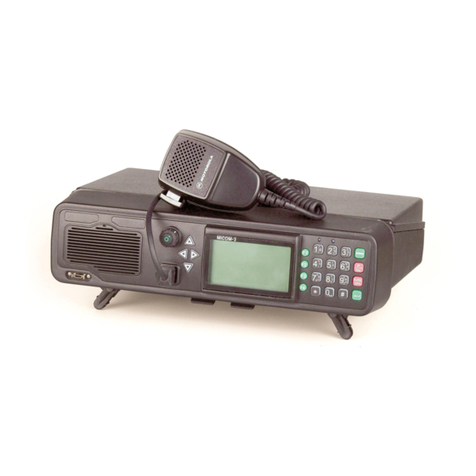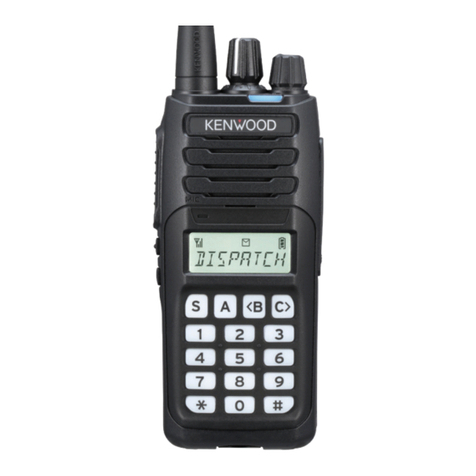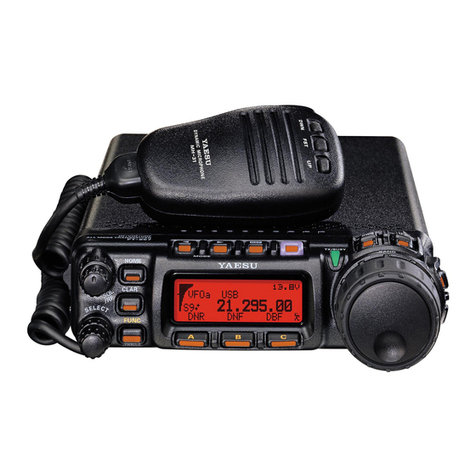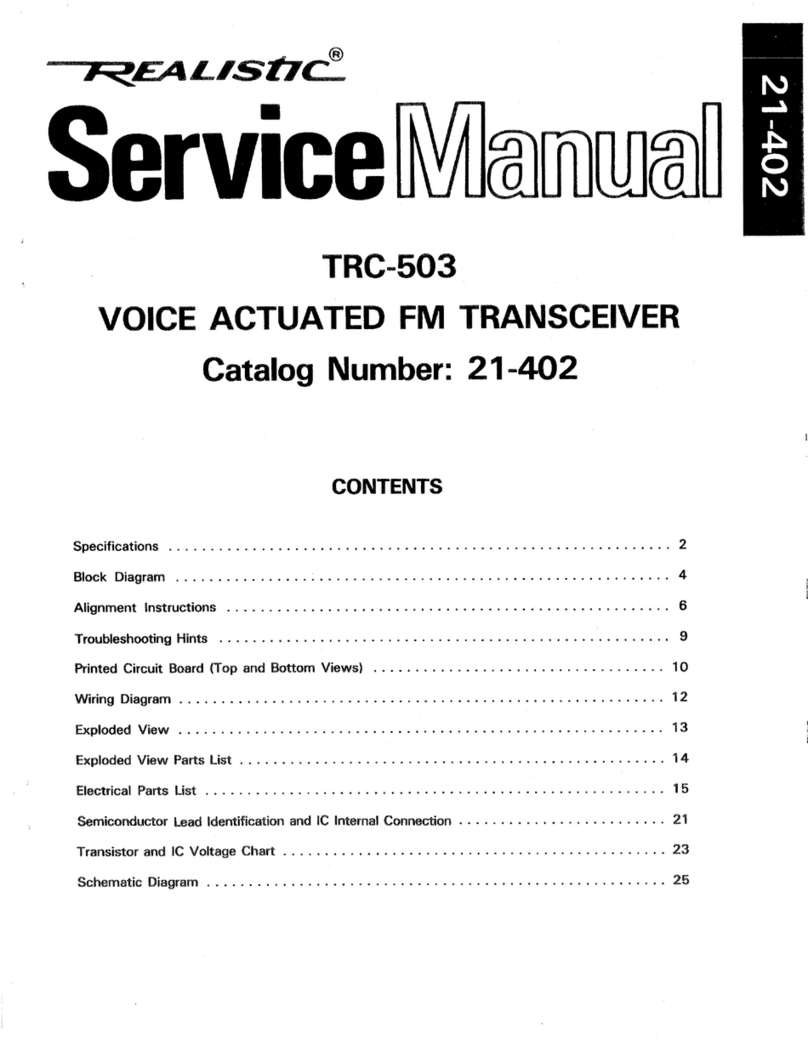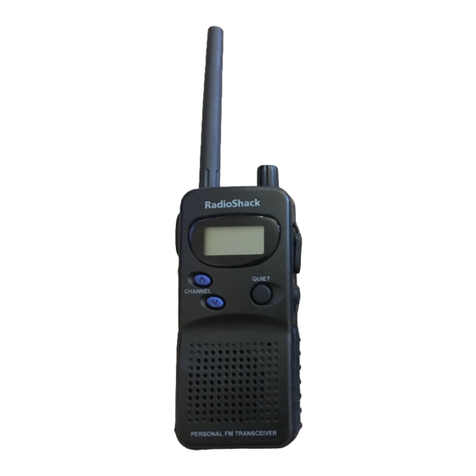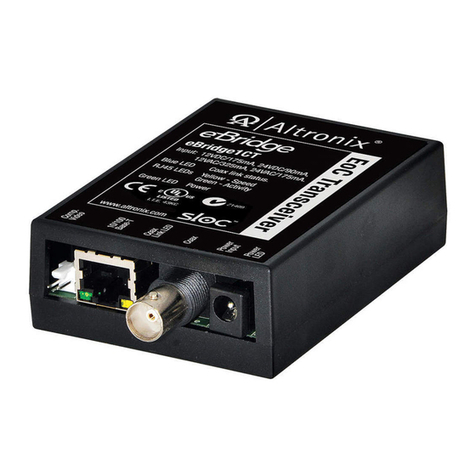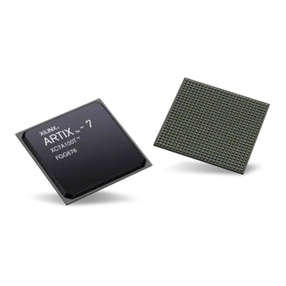Icom IC-80AD User manual

This device complies with Part 15 of the FCC Rules. Operation is
subject to the following two conditions: (1) this device may not cause
harmful interference, and (2) this device must accept any interference
received, including interference that may cause undesired operation.
WARNING: MODIFICATION OF THIS DEVICE TO RECEIVE CEL-
LULAR RADIOTELEPHONE SERVICE SIGNALS IS PROHIBITED
UNDER FCC RULES AND FEDERAL LAW.
INSTRUCTION MANUAL
i80AD
VHF/UHF DIGITAL TRANSCEIVER

i
FOREWORD
Thank you for purchasing this fine Icom product. We under-
stand you have a choice of many different radios in the mar-
ket place. Many hours of research and development went into
the design of your IC-80AD, following Icom’s philosophy of
“technology first.”
The IC-80AD VHF
/
UHF DIGITAL TRANSCEIVER is designed with
Icom’s superior technology and craftsmanship combining tra-
ditional analog technologies with the new digital technology,
Digital Smart Technologies for Amateur Radio (D-STAR), for
a balanced package.
With proper care, this product should provide you with years
of trouble-free operation. We want to take a couple of mo-
ments of your time to thank you for making your IC-80AD
your radio of choice, and hope you agree with Icom’s philoso-
phy of “technology first.”
EXPLICIT DEFINITIONS
WORD DEFINITION
RDANGER! Personal death, serious injury or an ex-
plosion may occur.
RWARNING! Personal injury, fire hazard or electric
shock may occur.
CAUTION Equipment damage may occur.
NOTE Recommended for optimum use. No risk
of personal injury, fire or electric shock.
FEATURES
MDV mode (Digital voice + Low-speed data
communication) operation-ready
– Text message and call sign exchange
– Transmitting position data with a GPS re-
ceiver
MGPS receiver connectable
– Optional
HM-189GPS is required
MDR (D-STAR Repeater) mode and repeater
list allow you to operate a D-STAR repeater
simply
MSplash-resistant construction (IPX4*)
*Only when the supplied battery pack (or optional
battery case), antenna and jack cover are at-
tached.
IMPORTANT
READ ALL INSTRUCTIONS carefully and completely
before using the transceiver.
SAVE THIS INSTRUCTION MANUAL— This
instruction manual contains important operating instructions
for the IC-80AD.

ii
RWARNING RF EXPOSURE! This device emits
Radio Frequency (RF) energy. Caution should be observed
when operating this device. If you have any questions regard-
ing RF exposure and safety standards please refer to the
Federal Communications Commission Office of Engineering
and Technology’s report on Evaluating Compliance with FCC
Guidelines for Human Radio Frequency Electromagnetic
Fields (OET Bulletin 65)
RWARNING! NEVER hold the transceiver so that
the antenna is very close to, or touching exposed parts of
the body, especially the face or eyes, while transmitting. The
transceiver will perform best if the microphone is 5 to 10 cm
(2 to 4 inches) away from the lips and the transceiver is verti-
cal.
RWARNING! NEVER operate the transceiver with
an earphone, headphones or other audio accessories at high
volume levels. Hearing experts advise against continuous
high volume operation. If you experience a ringing in your
ears, reduce the volume level or discontinue use.
RWARNING! NEVER operate the transceiver while
driving a vehicle. Safe driving requires your full attention—
anything less may result in an accident.
NEVER connect the transceiver to a power source of more
than 16 V DC. This will ruin the transceiver.
NEVER connect the transceiver to a power source using
reverse polarity. This will ruin the transceiver.
DO NOT operate the transceiver near unshielded electri-
cal blasting caps or in an explosive atmosphere.
DO NOT push the PTT unless you actually intend to trans-
mit.
BE CAREFUL! The transceiver will become hot when op-
erating it continuously for long periods.
DO NOT use or place the transceiver in direct sunlight
or in areas with temperatures below –20°C (–4˚F) or above
+60°C (+140˚F).
Place the unit in a secure place to avoid inadvertent use by
children.
DO NOT use harsh solvents such as benzene or alcohol
to clean the transceiver, because they can damage the trans-
ceiver’s surfaces.
PRECAUTIONS

iii
FCC INFORMATION
• FOR CLASS B UNINTENTIONAL RADIATORS:
This equipment has been tested and found to comply with the
limits for a Class B digital device, pursuant to part 15 of the
FCC Rules. These limits are designed to provide reasonable
protection against harmful interference in a residential instal-
lation. This equipment generates, uses and can radiate radio
frequency energy and, if not installed and used in accordance
with the instructions, may cause harmful interference to radio
communications. However, there is no guarantee that inter-
ference will not occur in a particular installation. If this equip-
ment does cause harmful interference to radio or television
reception, which can be determined by turning the equipment
off and on, the user is encouraged to try to correct the inter-
ference by one or more of the following measures:
• Reorient or relocate the receiving antenna.
• Increase the separation between the equipment and re-
ceiver.
• Connect the equipment into an outlet on a circuit different
from that to which the receiver is connected.
• Consult the dealer or an experienced radio/TV technician
for help.
For U.S.A. only
CAUTION: Changes or modifications to this device, not
expressly approved by Icom Inc., could void your authority to
operate this device under FCC regulations.
PRECAUTIONS
KEEP away from heavy rain, and never immerse the
IC-80AD in the water. The transceiver meets IPX4* require-
ments for splash resistance. However, once the transceiver
has been dropped, splash resistance cannot be guaranteed
because of possible damage to the transceiver’s case or wa-
terproof seal.
*Only when the supplied battery pack (or optional battery
case), antenna and jack cover are attached.
NEVER operate or touch the transceiver with wet hands.
This may result in an electric shock or may damage the trans-
ceiver.
Even when the transceiver power is OFF, a slight current still
flows in the circuits. Remove the battery pack or batteries
from the transceiver when not using it for a long time. Other-
wise, the installed battery pack or batteries will become ex-
hausted, and will need to be recharged or replaced.
• Important notes when using GPS receiver
Please do not use the HM-189GPS close to the transceiver’s
antenna. The transmit signal may cause GPS receiver mal-
function.

iv
Icom, Icom Inc. and the Icom logo are registered trademarks of Icom
Incorporated (Japan) in the United States, the United Kingdom, Ger-
many, France, Spain, Russia and/or other countries.
1
2
3
4
5
6
7
8
9
10
11
12
13
14
15
16
17
18
19
Microsoft, Windows and Windows Vista are registered trademarks of
Microsoft Corporation in the United States and/or other countries.
SUPPLIED ACCESSORIES
The following accessories are supplied with the transceiver.
qHand strap ····································································· 1
wAntenna ·········································································· 1
eBattery pack (BP-217) ···················································· 1
rBelt clip ···········································································1
tBattery charger (BC-167SA/SC/SV)* ····························· 1
* The BC-167SA, BC-167SC and BC-167SV have different shapes.
t
e
q
r
w

v
FOREWORD ····················································································· i
EXPLICIT DEFINITIONS··································································· i
FEATURES························································································ i
IMPORTANT······················································································ i
PRECAUTIONS············································································ ii, iii
FCC INFORMATION ······································································· iii
SUPPLIED ACCESSORIES···························································· iv
TABLE OF CONTENTS ······························································v–vii
1 ACCESSORY ATTACHMENT·················································1–2
NAntenna ···················································································1
NBelt clip ····················································································1
NHand strap ···············································································2
NBattery pack·············································································2
2 PANEL DESCRIPTION ··························································· 3–9
NFront, top and side panels ·······················································3
NFunction display·······································································8
3 BATTERY CHARGING ·······················································10–15
NCaution ··················································································10
NRegular charging ···································································12
NRapid charging·······································································13
NOptional battery case·····························································14
NBattery information ································································14
NExternal DC power operation·················································15
4 BASIC OPERATION ···························································16–28
NPower ON ··············································································16
NSetting audio volume ·····························································16
NSetting squelch level······························································17
NMonitor function ·····································································17
NMode selection·······································································18
N[DIAL] function assignment····················································20
NOperating band selection·······················································20
NSetting a tuning step······························································ 22
NSetting a frequency································································22
NLock function··········································································24
NReceiving···············································································24
NOperating mode selection······················································25
NAttenuator function·································································25
NTransmitting············································································26
NTransmit power selection ·······················································27
NTV channel operation·····························································27
5 REPEATER AND DUPLEX OPERATIONS ························29–33
NRepeater operation································································29
NDuplex operation····································································31
NAuto repeater function ···························································32
N1750 Hz tone ·········································································33
6 DV MODE PROGRAMMING···············································34–46
NAbout the D-STAR system ·····················································34
NCall sign programming···························································36
NRepeater list ··········································································39
NRepeater list programming ····················································40
NChanging a repeater list·························································45
NClearing a repeater list ··························································46
TABLE OF CONTENTS

vi
7 DV MODE OPERATION······················································47–76
NDigital mode operation···························································47
NCurrent call sign setting ·························································47
NReceiving a D-STAR repeater················································48
NReceived call sign··································································49
NCopying the call sign······························································51
NDR (D-STAR Repeater) mode operation ·······························53
NCalling CQ ·············································································54
NCalling a specific station ························································56
NSimplex operation in VFO······················································60
NRepeater operation in VFO ····················································62
NMessage operation ································································68
NAutomatic reply function ························································70
NEMR communication······························································71
NBreak-in communication ························································72
NLow-speed data communication············································74
NOther function for DV mode operation ···································76
8 GPS/GPS-A OPERATION ·················································· 77–90
NGPS operation ·······································································77
NGPS-A operation····································································90
9 MEMORY/CALL CHANNELS ·············································91–101
NGeneral description································································91
NSelecting a memory channel ·················································92
NSelecting a call channel·························································93
NMemory channel programming··············································94
NMemory bank setting ·····························································95
NMemory bank selection··························································96
NProgramming memory/bank/scan name································97
NSelecting memory/bank name indication·······························98
NCopying memory/call contents···············································99
NMemory clearing ··································································100
NErasing/transferring bank contents ······································101
10 SCAN OPERATION ························································102–110
NScan types··········································································· 102
NFull/band/programmed scan ···············································104
NScan edges programming····················································105
NMemory scan ······································································106
NMemory bank scan ······························································107
NSkip channel/frequency setting············································108
NScan resume condition ························································110
11 PRIORITY WATCH·························································· 111–114
NPriority watch types ·····························································111
NPriority watch operation ·······················································112
12 MENU SCREEN OPERATION········································115–142
NGeneral ············································································115
NMENU screen indication and arrangement··························116
NItems list ············································································117
NDUP/TONE items (DUP.T) ···················································119
NScan items (SCAN) ·····························································121
NSet mode items (SET) ·························································124
Function set mode items (FUNC)····································124
Display set mode items (DISP) ·······································129
Sounds set mode items (SOUNDS)································130
NDV set mode items (DV SET) ··············································132
NGPS mode items (GPS)·······················································136
TABLE OF CONTENTS 1
2
3
4
5
6
7
8
9
10
11
12
13
14
15
16
17
18
19

vii
TABLE OF CONTENTS
13 OTHER FUNCTIONS ······················································143–159
NProgramming a DTMF code ················································143
NTransmitting a DTMF code···················································144
NClearing a DTMF memory ···················································145
NConfirming a DTMF memory ···············································146
NSetting DTMF transfer speed···············································146
NTone frequency and DTCS code··········································147
NDigital code and digital call sign setting ······························148
NTone/DTCS squelch ·····························································150
NDigital squelch ·····································································151
NPocket beep function ···························································151
NDTCS polarity setting···························································152
NTone scan·············································································152
NBeep tones···········································································153
NDial speed acceleration ·······················································153
NKey lock effect······································································154
NWeather channel operation··················································154
NPower save ··········································································156
NAuto power OFF···································································156
NAuto power ON ····································································156
NTime-out timer······································································157
NPTT lock···············································································157
NDisplay backlighting ·····························································157
NLCD contrast········································································157
NCloning function···································································158
NResetting··············································································159
14 TROUBLESHOOTING·····························································160
15 SPECIFICATIONS···························································161–162
16 OPTIONS ········································································163–166
NOptional HM-75A
REMOTE CONTROL SPEAKER MICROPHONE
·····164
NOptional HM-189GPS GPS SPEAKER MICROPHONE ···············166
INDEX ·················································································167–173

1
1
ACCESSORY ATTACHMENT
1
NAntenna
Insert the supplied antenna into the antenna connector and
screw down the antenna as shown below.
Jack cover
NEVER carry the transceiver by holding the antenna.
KEEP the jack cover attached when jack is not in use to pro-
tect the connector from dust and moisture.
For your information
Third-party antennas may increase transceiver
performance. An optional AD-92SMA ANTENNA
CONNECTOR ADAPTER is available to connect an
antenna that has a BNC connector.
NBelt clip
Supplied screws
CAUTION:
USE the supplied screws only. Using screws longer than
specified could damage the transceiver.

2
1ACCESSORY ATTACHMENT
NHand strap
To facilitate carrying the transceiver, slide the hand strap
through the loop on the top of the belt clip as illustrated
below.
Handstrap
NBattery pack
Attach the Li-Ion battery pack (BP-217) or battery case (BP-
216) as illustrated below.
• Charge the Li-Ion battery pack before use. (pgs. 12, 13)
q
w
Battery pack/Battery case
Latch

3
2
PANEL DESCRIPTION
1
2
3
4
5
6
7
8
9
10
11
12
13
14
15
16
17
18
19
NFront, top and side panels
Speaker
Keypad
Internal microphone
Function display
q
y
u
t
r
w
e
i
o
!1
!0
qANTENNA CONNECTOR (p. 1)
Connects the supplied antenna.
• An optional AD-92SMA adapter (p. 163) is available for
connecting an antenna with a BNC connector.
wPTT SWITCH [PTT] (p. 26)
Push and hold to transmit, release to receive.
eTX/RX INDICATOR [TX/RX] (pgs. 24, 26)
Lights green while receiving a signal or when the squelch
is open; lights red while transmitting.
rSQUELCH KEY [SQL] (p. 17)
±Push and hold to open the squelch temporarily and
monitor the operating frequency.
±While pushing and holding this key, rotate [DIAL] to ad-
just the squelch level.
tMENU • LOCK KEY [MENU ]
±Push to enter menu screen indication ON and OFF.
(p. 115)
• Pushing [V/MHz] also exits from menu screen.
±Push and hold for 1 sec. to toggle the lock function ON
and OFF. (p. 24)
yPOWER KEY [PWR]
Push and hold for 1 sec. to turn the transceiver power ON
and OFF. (p. 16)

4
2PANEL DESCRIPTION
Speaker
Keypad
Internal microphone
Function display
q
y
u
t
r
w
e
i
o
!1
!0
uVOLUME CONTROL KEY []/[]
±Adjust audio volume level. (p. 16)
±[] enters or sends the DTMF code ‘D.’ (pgs. 143–145)
The function of tuning control and volume control can be
traded. See page 20 for details.
iCONTROL DIAL [DIAL]
±Rotate to tune the operating frequency. (p. 22)
±During memory mode, rotate to select the memory
channel. (pgs. 18, 92)
±While scanning, changes the scanning direction.
(pgs. 53, 104, 106, 107)
±While pushing and holding [SQL],sets the squelch
level. (p. 17)
±After pushing [BAND] during memory mode operation,
selects the programmed bank. (p. 96)
±During menu screen operation, rotate to select the set
items or values. (p. 115)
The function of tuning control and volume control can be
traded. See page 20 for details.
o
EXTERNAL SPEAKER/MICROPHONE JACK [SP/MIC]
Connect a cloning cable, optional speaker microphone or
headset, if desired.
See page 163 for a list of available options.
Be sure to turn power OFF before connectiong/discon-
necting optional equipment to/from the [SP/MIC] jack.

5
2
PANEL DESCRIPTION
1
2
3
4
5
6
7
8
9
10
11
12
13
14
15
16
17
18
19
!0EXTERNAL DC IN JACK [DC IN]
±Connects the supplied wall charger, BC-167SA/SC/SV,
to charge the attached battery pack. (p. 12)
±Connect an external DC power supply through the op-
tional CP-12L, CP-19R or OPC-254L for external DC
operation. (p. 15)
!1
DATA JACK [DATA] (pgs. 74, 77, 158)
Connects a PC through the optional data communication
cable, OPC-1529R, for low-speed data communication in
DV mode or cloning operation. The jack and cable are also
used to connect a GPS receiver.
DKEYPAD
±Push to input numeral for frequency input, memory chan-
nel selection, etc.
±Push to enter or send the DTMF code. (pgs. 143–145)
1 • VOLUME/DIAL KEY [1] • [V
<
=
>
D](1)
±Numeral input and DTMF code: ‘1’
±Push and hold for 1 sec. to exchange the assigned
functions between [DIAL] and []/[]. (p. 20)
2 • TUNING STEP KEY [2] • [TS](2)
±Numeral input and DTMF code: ‘2’
±Push and hold for 1 sec. to enter tuning step set
mode. (p. 22)
±During menu screen operation or select memory
write mode, push to select the set items or values.
(p. 115)
3 • OUTPUT POWER KEY [3] • [LOW](3)
±Numeral input and DTMF code: ‘3’
±Push and hold for 1 sec. to select the output
power. (p. 27)
• Selects the transmit output power from high, mid, low
and S-low.
• While pushing and holding this key, [DIAL] rotation se-
lects the output power.
4 • DUPLEX KEY [4] • [DUP](4)
±Numeral input and DTMF code: ‘4’
±Push and hold for 1 sec. to select minus duplex,
plus duplex, and simplex operation. (p. 31)
• “DUP–” (minus duplex), “DUP” (plus duplex) and no
indication (simplex) appear in order.
• While pushing and holding this key, [DIAL] rotation se-
lects the duplex operation.
±During menu screen operation, push to select the
upper layer. (p. 115)

6
2PANEL DESCRIPTION
5 • SKIP KEY [5] • [SKIP](5)
±Numeral input and DTMF code: ‘5’
±Push and hold to turn the frequency skip function
ON and OFF in VFO mode, or set the memory
channel as the following skip channel in memory
mode in order. (pgs. 102, 108, 109)
• “SKIP” appears when memory skip, “PSKIP” appears
when frequency skip and no indication appears when
non skip channel is set.
• While pushing and holding this key, [DIAL] rotation se-
lects the skip condition.
±During menu screen operation, push to enter or
exit to/from the selected set items, etc. (p. 115)
6 • MEMORY NAME KEY [6] • [M.N](6)
±Numeral input and DTMF code: ‘6’
±Push and hold for 1 sec. to turn the memory or
bank name indication ON and OFF. (p. 98)
• While pushing and holding this key, [DIAL] rotation se-
lects the memory or bank indication.
±During menu screen operation, push to select the
lower layer. (p. 115)
7 • TONE/DIGITAL SQUELCH KEY
[7] • [TONE](7)/[DSQ](7)
±Numeral input and DTMF code: ‘7’
±During FM/FM-N mode operation, push and hold
for 1 sec. to select repeater tone, tone squelch,
tone squelch reverse, DTCS squelch, DTCS
squelch reverse and no tone operation in se-
quence. (p. 150)
• Pocket beep function is available for tone squelch and
DTCS squelch. (p. 151)
±During DV mode operation, push and hold for 1
sec. to select digital call sign squelch, digital code
squelch and no squelch operation in sequence.
(p. 151)
• Pocket beep function is available. (p. 151)
8 • RX CALL SIGN SET KEY [8] • [RXCS](8)
±Numeral input and DTMF code: ‘8’
±During DV mode operation, push and hold for
1 sec. to set the received call signs (station and
repeaters) to current call sign. (p. 50)
±During menu screen operation or select memory
write mode, push to select the set items or values.
(p. 115)
9 • TONE SCAN/CALL SIGN KEY
[9] • [T.SCAN](9)/[CS](9)
±Numeral input and DTMF code: ‘9’
±During FM/FM-N mode operation, push and hold
for 1 sec. to start tone scan function. (p. 152)
±During DV mode operation (including DR mode
operation), push and hold for 1 sec. to enter the
current call sign mode. (pgs. 48, 59)

7
2
PANEL DESCRIPTION
2
0 • DTMF KEY [0] • [DTMF](0)
±Numeral input and DTMF code: ‘0’
±Push and hold for 1 sec. to select DTMF memory
mode. (p. 143)
VFO/MHz • SCAN KEY [V/MHz] • [SCAN](V/MHz)
±DTMF code: ‘A’
±Push to select VFO mode. (p. 18)
±During VFO mode operation, push to select 1 MHz
and 10 MHz tuning steps. (p. 22)
±Push and hold for 1 sec. to enter scan type selec-
tion mode. (pgs. 104, 106, 107)
• Push again to start the scan.
±Cancels numeral key input. (p. 23)
±During menu screen operation or select memory
write mode, push to return to previous operating
condition. (pgs. 94, 115)
MEMORY/CALL • SELECT MEMORY WRITE KEY
[M/CALL] • [S.MW](M/CALL)
±DTMF code: ‘B’
±Push to select memory mode, call channel, TV
channel and weather channel. (pgs. 18, 19, 27,
92, 93, 154)
±Push and hold for 1 sec. to enter select memory
write mode. (p. 94)
DR (D-STAR REPEATER) KEY [DR]
±DTMF code: ‘C’
±Push to select DR mode. (pgs. 19, 53, 54, 56)
±During DR mode operation, push to enter the ac-
cess repeater selection.
VOLUME CONTROL (UP) KEY []
±DTMF code ‘D.’
±Adjust audio volume level. (p. 16)
BAND • MODE KEY [BAND] • [MODE](BAND)
±DTMF code: ‘1(indication: E)’
±During VFO mode operation, push to select an
operating frequency band. (pgs. 20, 21)
±During memory mode operation, push to enter
memory bank group selection. (p. 96)
±Push and hold for 1 sec. to select the operating
mode. (p. 25)
.• UR KEY [.] • [UR](.)
±DTMF code ‘# (indication: F).’
±Inputs MHz digit for frequency input.
±During DV mode operation (including DR mode
operation), push and hold for 1 sec. to enter the
station call sign selection mode. (pgs. 60, 61)
• Rotate [DIAL] to select the call sign.
During other than DV mode operation, pushing
and holding this key enters the station call sign
selection mode with changing the operating
mode to DV mode.

NFunction display
!
2
!
3
y
i
o!0
!1
u
!4
!5
!6
qw e r t
qBATTERY INDICATOR (pgs. 12, 14)
±“” (battery indicators) appear when the battery pack
is attached.
±“” appears when the battery cells/pack must be
changed/charged.
±The indicators show “ ,” “ ” and “ ” in sequence
while charging the attached battery pack.
wKEY LOCK INDICATOR (p. 24)
Appears when the key lock function is activated.
eDUPLEX INDICATOR (p. 31)
“DUP” appears when plus duplex, “DUP–” appears when
minus duplex is selected.
rTONE INDICATOR
• While operating in FM/FM-N mode;
±“T” appears while the subaudible tone encoder is in use.
(p. 29)
±“T SQL” appears while the tone squelch function is in
use. (p. 150)
±“T SQL-R” appears while the reverse tone squelch func-
tion is in use. (p. 150)
±“DTCS” appears while the DTCS squelch function is in
use. (p. 150)
±“DTCS -R” appears while the reverse DTCS squelch
function is in use. (p. 150)
±“S” appears with the “T SQL” or “DTCS” indicator
while the pocket beep function (with CTCSS or DTCS)
is in use. (p. 151)
• While operating in DV mode;
±“D SQL” appears while the digital call sign squelch func-
tion is in use. (p. 151)
±“CSQL” appears while the digital code squelch function
is in use. (p. 151)
±“S” appears with the “D SQL” or “CSQL” indicator
while the pocket beep function (with digital call sign or
digital code squelch) is in use. (p. 151)
8
2PANEL DESCRIPTION

9
2
PANEL DESCRIPTION
2
tSKIP INDICATOR
±“SKIP” appears when the selected memory channel is
set as a skip channel. (pgs. 108, 109)
±“PSKIP” appears when the displayed frequency is set
as a skip frequency in memory mode. (pgs. 108, 109)
±“PSKIP” appears during the frequency skip scan func-
tion is ON in VFO mode. (p. 102)
yDR (D-STAR REPEATER) INDICATOR
(pgs. 19, 53, 54, 56)
Appears when DR mode is selected.
uMEMORY INDICATOR (pgs. 18, 92)
Appears when memory mode is selected.
iMEMORY CHANNEL NUMBER INDICATOR
±Shows the selected memory channel number.
(pgs. 18, 92)
±“C0” or “C1” appears when the call channel is selected.
(pgs. 19, 93)
±“TV” appears when the TV channel is selected.
(pgs. 19, 27)
oGPS INDICATOR
Appears while GPS function is in use.
• GPS indicator can be turned OFF in GPS.SET mode. (p. 137)
±Stays ON when GPS receiver is connected and a valid
position data is received.
±Blinks when an invalid position data is received.
!0VOLUME INDICATOR (p. 20)
Appears when [DIAL] is assigned volume control, then
[]/[]are assigned tuning controls.
!1PRIORITY WATCH INDICATOR (pgs. 112–114)
Appears when priority watch is in use.
!2S/RF METER
±Shows the relative signal strength while receiving sig-
nals. (p. 24)
±Shows the output power level while transmitting.
(pgs. 26, 27)
!3POWER INDICATOR (p. 27)
±“L” appears when low power is selected.
±“SL” appears when S-low power is selected.
±“M” appears when middle power is selected.
±No indicator appears when high power is selected.
!4ATTENUATOR INDICATOR (p. 25)
Appears when the RF attenuator is in use.
!5OPERATING MODE INDICATOR (p. 25)
Shows the selected operating mode.
• DV, FM, FM-N, WFM and AM are available, depending on op-
erating band.
• “DVG” or “DV A” appears when GPS transmission or GPS-A
transmission is selected in DV mode. (p. 138)
!6FREQUENCY READOUT
±Displays a variety of information, such as operating fre-
quency, set mode contents.
• The decimal point blinks during scan.
±During memory mode operation, the programmed
memory or memory bank name is displayed.

10
BATTERY CHARGING
3
NCaution
• RDANGER! Use and charge only specified Icom battery
packs with Icom radios. Only Icom battery packs are tested
and approved for use with Icom radios. Using third-party or
counterfeit battery packs may cause smoke, fire, or cause
the battery to burst.
DBattery caution
• RDANGER! DO NOT hammer or otherwise impact the bat-
tery. Do not use the battery if it has been severely impacted
or dropped, or if the battery has been subjected to heavy
pressure. Battery damage may not be visible on the outside
of the case. Even if the surface of the battery does not show
cracks or any other damage, the cells inside the battery may
rupture or catch fire.
•
RDANGER! NEVER use or leave battery pack in areas
with temperatures above +60˚C (+140˚F). High tempera-
ture buildup in the battery, such as could occur near fires
or stoves, inside a sun heated car, or in direct sunlight may
cause the battery to rupture or catch fire. Excessive tem-
peratures may also degrade battery performance or shorten
battery life.
•
RDANGER! DO NOT expose the battery to rain, snow,
seawater, or any other liquids. Do not charge or use a wet
battery. If the battery gets wet, be sure to wipe it dry before
using.
•
RDANGER! NEVER incinerate a used battery pack since
internal battery gas may cause it to rupture, or may cause
an explosion.
•
RDANGER! NEVER solder the battery terminals, or
NEVER modify the battery pack. This may cause heat gen-
eration, and the battery may burst, emit smoke or catch
fire.
•
RDANGER! Use the battery only with the transceiver for
which it is specified. Never use a battery with any other
equipment, or for any purpose that is not specified in this
instruction manual.
•
RDANGER! If fluid from inside the battery gets in your
eyes, blindness can result. Rinse your eyes with clean water,
without rubbing them, and see a doctor immediately.
•
WARNING! Immediately stop using the battery if it emits
an abnormal odor, heats up, or is discolored or deformed. If
any of these conditions occur, contact your Icom dealer or
distributor.
•
WARNING! Immediately wash, using clean water, any part
of the body that comes into contact with fluid from inside
the battery.
Misuse of Lithium-Ion batteries may result in the following
hazards: smoke, fire, or the battery may rupture. Misuse
can also cause damage to the battery or degradation of
battery performance.

11
3
BATTERY CHARGING
1
2
3
4
5
6
7
8
9
10
11
12
13
14
15
16
17
18
19
• WARNING! NEVER put the battery in a microwave oven,
high-pressure container, or in an induction heating cooker.
This could cause a fire, overheating, or cause the battery
to rupture.
•
CAUTION: Always use the battery within the specified tem-
perature range, –20˚C to +60˚C (–4˚F to +140˚F). Using the
battery out of its specified temperature range will reduce the
battery’s performance and battery life.
•
CAUTION: Shorter battery life could occur if the battery is
left fully charged, completely discharged, or in an exces-
sive temperature environment (above +50˚C; +122˚F) for an
extended period of time. If the battery must be left unused
for a long time, it must be detached from the radio after dis-
charging. You may use the battery until the battery indicator
shows half-capacity, then keep it safely in a cool dry place
at the following temperature range:
–20˚C (–4˚F) to +50˚C (+122˚F) (within a month).
–20˚C (–4˚F) to +35˚C (+95˚F) (within three months).
–20˚C (–4˚F) to +20˚C (+68˚F) (within a year).
DCharging caution
• RDANGER! NEVER charge the battery pack in areas with
extremely high temperatures, such as near fires or stoves,
inside a sun-heated vehicle, or in direct sunlight. In such
environments, the safety/protection circuit in the battery will
activate, causing the battery to stop charging.
•
WARNING! DO NOT charge or leave the battery in the bat-
tery charger beyond the specified time for charging. If the
battery is not completely charged by the specified time, stop
charging and remove the battery from the battery charger.
Continuing to charge the battery beyond the specified time
limit may cause a fire, overheating, or the battery may rup-
ture.
•
WARNING! NEVER insert the transceiver (battery attached
to the transceiver) into the charger if it is wet or soiled. This
could corrode the battery charger terminals or damage the
charger. The charger is not waterproof.
•
CAUTION: DO NOT charge the battery outside of the speci-
fied temperature range: 0˚C to +35˚C (+32˚F to +95˚F).
Icom recommends charging the battery at +25˚C (+77˚F).
The battery may heat up or rupture if charged out of the
specified temperature range. Additionally, battery perfor-
mance or battery life may be reduced.

12
3BATTERY CHARGING
NRegular charging
Prior to using the transceiver for the first time, the battery
pack must be fully charged for optimum life and operation.
DBattery indicators
The indicators show “ ,” “ ” and “ ” in sequence and
“CHARGE” appears while charging (when the transceiver’s
power is OFF). The indicators and “CHARGE” disappear
when the battery pack is completely charged.
DCharging note
• Be sure to turn the transceiver power OFF.
Otherwise the battery pack will not be charged completely
or will take much longer to charge.
• External DC power operation becomes possible when using
an optional CP-12L, CP-19R or OPC-254L. The attached
battery pack is also charged simultaneously, except during
transmit (see p. 15 for more details).
• The external DC power supply voltage must be between
10–16 V to charge the battery pack and for operation when
using an optional OPC-254L.
• BC-167
• CP-12L (Optional)
• OPC-254L (Optional)
to AC outlet
to cigarette lighter
socket (12 V DC)
to 12 V DC
(power supply)
White: +
Black: _
Transceiver
to
[DC IN]
Turn power OFF while
charging the battery
pack.
The BC-167SA,
BC-167SC and
BC-167SV have
different shapes.
• Charging time period:
Approx. 6 hours
BP-217 • CP-19R (Optional)
Other manuals for IC-80AD
3
Table of contents
Other Icom Transceiver manuals
